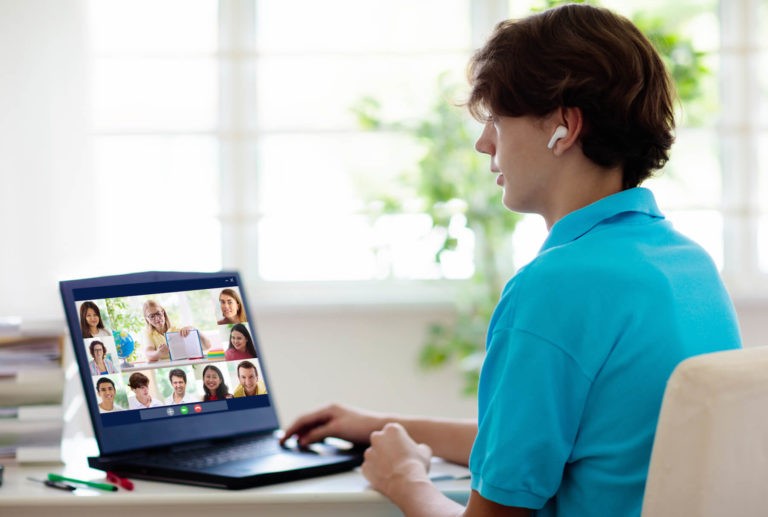The dynamics of classroom instruction have shifted drastically within the last year. Whether teaching in-person or online, the age of virtual learning has quickly come upon educators across the country and the world. As teachers, it is our job to implement and utilize these new technologies to make online learning an effective and beneficial experience for our students. Aside from delivering curriculum, teachers must become knowledgeable in the various elements of the virtual platforms they are using. Let’s take a closer look at some of the hacks and hazards of using Zoom for virtual learning.
Set Guidelines and Behavior Expectations
Just as it is important to establish guidelines within your regular classroom, it is equally important to set clear guidelines for virtual learning so that students understand the behavior expectations when conducting class virtually. From the microphone being muted at the appropriate times to keeping their camera on, all of these expectations should be clearly outlined for students.
Protect Yourself from Zoom-bombing
Presenting instructional content in a virtual platform is new and exciting, but it also comes with the possibility of unwelcome distractions, also known as Zoom-bombing. There are several steps that you may take to avoid this from happening. Students need a link to join the meeting, but sometimes students may decide to share the link with outside people. To avoid this, there are several steps you can take:
- Only share links to meetings in password protected programs, such as Blackboard, Google Classroom, email, etc.
- It would be beneficial to establish a Waiting Room. The Waiting Room feature on Zoom allows the teacher to monitor attendees and admit students to the meeting when he or she is ready. It also gives the teacher the ability to not admit and remove any unauthorized attendees. If for any reason an unauthorized user gets admitted to your meeting, Zoom allows you to remove that user from the meeting manually, too.
- Zoom gives you the ability to lock the meeting once it has begun. This prevents any other attendees from joining the meeting.
There are also a few additional steps to take to prevent Zoom-bombing! As the teacher or facilitator of the meeting, Zoom allows you to control the settings of the meeting. Students should be “muted” upon entry to the meeting. Although it sounds like fun, students should not be allowed to rename themselves! You may also want to disable the chat features, preventing students from sharing out at inappropriate times, etc.
Zoom offers its users the ability to annotate materials and screen share. If this feature isn’t managed, students can annotate materials on the screen and share their own screens throughout the meeting. Talk about a distraction! The teacher should be the only member of the meeting with the ability to screen share and annotate to decrease the number of distractions and keep student focus on the instruction being presented.
Use Zoom for Education
Zoom for Education is another effective tool for successfully implementing virtual learning. This is a tool that can be purchased and used by your school or school district to safely deliver instruction online. This type of Zoom account is compliant with FERPA, COPPA, and other states’ student privacy laws. It is important to note that standard Zoom accounts are not complaint with student privacy laws; thus, additional precautions must be taken when using the platform in that manner.
Students Don’t Need Zoom Accounts
Students do not need Zoom accounts to use the platform. This can be both an advantage and disadvantage to teachers. As a general user of Zoom, students can have access to screen sharing capabilities unless turned off in advance by the teacher; however, allowing students to have their own Zoom account opens the door for unmonitored chatting, meetings, etc. The most useful solution would be to grant students access to Zoom via your school system’s domain if it is available.
Recording Lessons
Zoom gives teachers the option to record meetings. This is an amazing feature as it allows any student who had to miss instruction the opportunity to view the lesson at a later time to catch up on any missed material. Not only is this beneficial to the student, it saves you time as you do not have to reteach the material the next day. The advantages of recording are numerous, but it is important that any and all recordings adhere to school policy and avoid FERPA violations. When recording, you should only include the parts where you are speaking and delivering instruction. If recordings or images of students are part of your recording, they should be strictly limited to those students with permission to be included.
Group Work
Finally, one of the best features of Zoom is its ability to facilitate group work. The teacher may create and assign students to breakout rooms under the Zoom settings menu. Within the breakout rooms, students can work together via chat or video and have the ability to screen share as needed. The teacher never has to worry about groups staying on task or needing help, because he or she can drop in on groups during breakout time to monitor their progress and address any issues they may be having.




